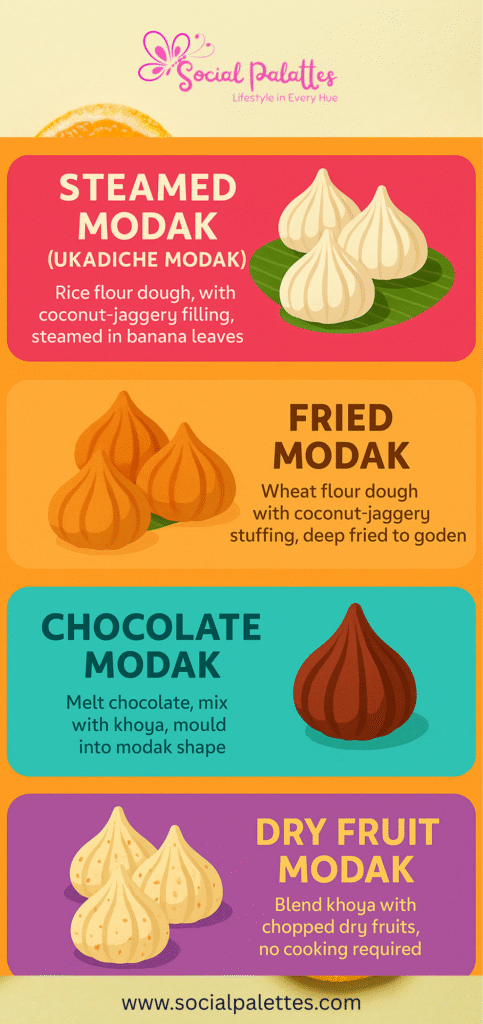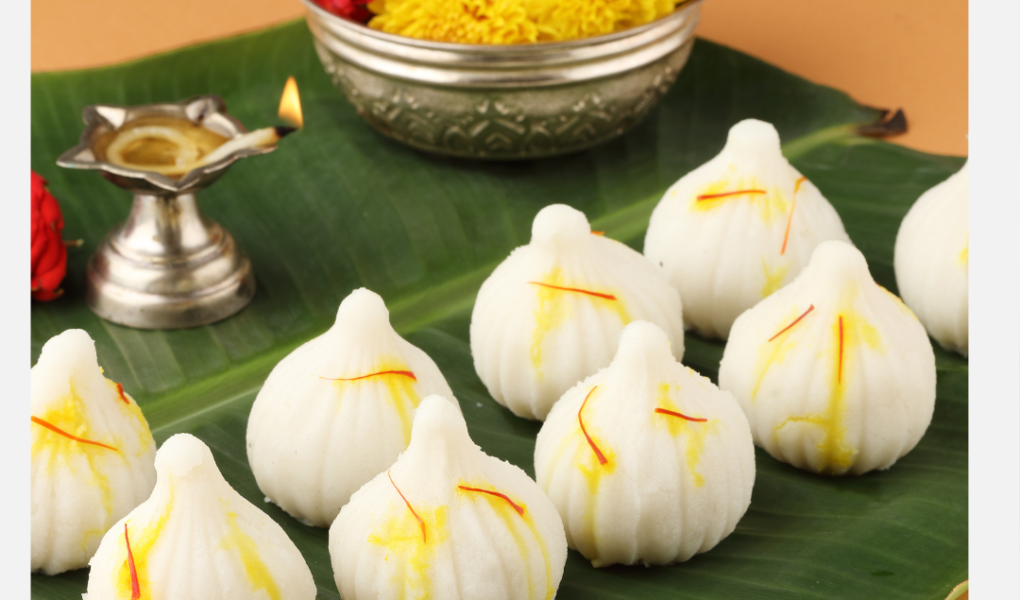Discover the different types of modak, a traditional Indian sweet, and learn how to make them at home. From steamed to fried, and even chocolate modak, there’s a variety for everyone!
Introduction
Modak is a beloved Indian sweet, especially popular during the festival of Ganesh Chaturthi. Known for its unique shape and delightful taste, modak comes in various forms, each offering a distinct flavor and texture. In this blog, we’ll explore some of the most popular varieties of modak and provide simple recipes for you to try at home.
Steamed Modak (Ukadiche Modak)

Steamed modak, also known as ukadiche modak, is the most traditional variety. It has a soft, melt-in-your-mouth outer layer made from rice flour and is filled with a sweet mixture of coconut and jaggery.
Recipe:
Ingredients: Rice flour, water, ghee, grated coconut, jaggery, cardamom powder.
Instructions:
- Prepare the dough by mixing rice flour with hot water and ghee.
- Make the filling by cooking grated coconut and jaggery until it thickens, then add cardamom powder.
- Shape the dough into small cups, fill with the coconut mixture, and steam until cooked.
Interesting Fact: Ukadiche modak is believed to be Lord Ganesha’s favorite sweet, which is why it is prominently featured during Ganesh Chaturthi celebrations.
Fried Modak

Fried modak offers a crispy alternative to the steamed version. The outer layer is made from wheat flour and is deep-fried to a golden brown, while the filling remains the same as the steamed modak.
Recipe:
Ingredients: Wheat flour, ghee, grated coconut, jaggery, cardamom powder, oil for frying.
Instructions:
- Prepare the dough by mixing wheat flour with ghee and water.
- Make the filling as described above.
- Shape the dough, fill with the coconut mixture, and deep fry until golden brown.
Case Study
In a small village in Maharashtra, a local sweet shop started offering fried modak during Ganesh Chaturthi. The unique twist on the traditional sweet became so popular that the shop now sells over 1,000 fried modaks daily during the festival season.
Chocolate Modak

For a modern twist, chocolate modak is a delightful fusion of traditional and contemporary flavors. It combines the richness of chocolate with the classic modak shape.
Recipe:
Ingredients: Dark chocolate, condensed milk, cocoa powder, ghee.
Instructions:
- Melt dark chocolate and mix with condensed milk and cocoa powder.
- Shape the mixture into modak molds and let it set in the refrigerator.
Interesting Fact:
Chocolate modak has gained popularity among younger generations, making it a trendy addition to the traditional modak varieties.
Rava Modak

(Suji Modak)
Rava modak, made from semolina (suji), is another popular variety. It has a smooth, velvety texture and is filled with the traditional coconut-jaggery mixture.
Recipe:
Ingredients: Semolina, milk, ghee, grated coconut, jaggery, cardamom powder.
Instructions:
- Roast semolina in ghee, then add milk and cook until it thickens.
- Prepare the filling as described above.
- Shape the semolina mixture, fill with the coconut mixture, and let it set.
Case Study
A famous sweet shop in Pune introduced rava modak as a healthier alternative to traditional modak. The shop’s sales increased by 20% during the festival season, thanks to health-conscious customers.
Kesar Modak
Kesar modak is a luxurious version made with saffron (kesar) and milk. It has a rich, aromatic flavor and is often served as a special treat during festivals.

Recipe:
Ingredients: Milk, saffron strands, sugar, ghee, rice flour.
Instructions:
- Soak saffron strands in warm milk.
- Prepare the dough with rice flour, ghee, and saffron-infused milk.
- Shape the dough, fill with a sweet mixture of your choice, and steam until cooked.
Interesting Fact: Saffron, used in kesar modak, is one of the most expensive spices in the world, adding a touch of luxury to this sweet treat.
Shaping perfect modaks can be a bit tricky, but with some practice and these tips, you’ll get the hang of it:
Use Fresh Dough
Ensure your dough is fresh and pliable. If it’s too dry, it will crack, and if it’s too wet, it will be difficult to shape.
Keep Hands Greased
Lightly grease your hands with ghee or oil to prevent the dough from sticking while shaping the modaks.
Consistent Size
Use a small scoop or spoon to measure the dough and filling, ensuring each modak is of uniform size.
Thin Outer Layer:Roll the dough into thin discs. A thick outer layer can make the modak chewy and less enjoyable.
Proper Sealing
Ensure the edges are sealed properly to prevent the filling from leaking out during steaming or frying.
Use Moulds
If you’re new to making modaks, using molds can help achieve a consistent shape. Place the dough in the mold, add the filling, and then seal it.
Practice Pinching Technique
If you prefer the traditional hand-shaped modaks, practice the pinching technique. Pinch the edges of the dough to form pleats and then gather them at the top to seal.
Steam Correctly
For steamed modaks, make sure the steamer is preheated and use a muslin cloth or banana leaf to prevent sticking.
Cool Before Serving
Allow the modaks to cool slightly before serving. This helps them firm up and makes them easier to handle.
Patience and Practice
Shaping perfect modaks takes patience and practice. Don’t be discouraged if they don’t turn out perfect the first time.
Decorating modaks can be a fun and creative process!
Here are some ideas to make your modaks look as delightful as they taste:
Edible Gold or Silver Leaf
Add a touch of luxury by placing small pieces of edible gold or silver leaf on top of each modak. This is especially popular for festive occasions.
Coloured Dough
Use natural food coloring to dye the dough in different colors. You can create a rainbow of modaks or use colors that match the theme of your celebration.
Sprinkles and Edible Glitter
Decorate the modaks with colorful sprinkles or edible glitter for a festive and playful look. This is particularly appealing to kids.
Nuts and Dried Fruits
Garnish the top of each modak with a piece of almond, pistachio, or cashew. You can also use dried fruits like raisins or cranberries for added texture and flavor.
Chocolate Drizzle
Drizzle melted chocolate over the modaks for a decadent touch. You can use white, milk, or dark chocolate, or even a combination of them.
Saffron Strands
Place a few strands of saffron on top of each modak. This not only adds a beautiful golden color but also enhances the aroma and flavor.
Coconut Flakes
Roll the modaks in desiccated coconut or sprinkle coconut flakes on top for a snowy, festive appearance.
Edible Flowers
Use small edible flowers like marigold petals or rose petals to decorate the modaks. This adds a natural and elegant touch.
Icing and Fondant
If you enjoy working with icing or fondant, you can create intricate designs or patterns on the modaks. This is a great way to personalize them for special occasions.
Themed Moulds
Use modak moulds with different patterns or shapes to create unique designs. You can find moulds with floral patterns, geometric shapes, or even festive symbols.
Infographics – Types of modak and Recipies
✨ Ganesh Chaturthi Special! ✨
🪔 Ever wondered how many delicious varieties of Modak exist?
👇 Dive into our colorful infographic showcasing different types of Modaks — from the classic Steamed Modak to the indulgent Chocolate and Dry Fruit ones!
📌 Each type comes with a quick recipe so you can try them all this festive season.

Check our other blogs which may interest you…
Conclusion
Modak is a versatile sweet that can be enjoyed in many forms. Whether you prefer the traditional steamed modak or want to try a modern chocolate version, there’s a modak for every taste. Try these recipes at home and bring a touch of festivity to your kitchen!
Disclaimer: Some visuals on this blog are created using AI-based design tools for illustrative purposes.



[…] Modak […]
[…] Modak […]
[…] Modak: Explore the Delicious Varieties […]